
As discussed in previous articles, two meta-analyses indicate light loads can produce similar muscle growth to heavier loads, when reps are performed to or close to failure (the point at which no more repetitions can be performed) (one, two).
Meta-analyses are studies that combine the results of numerous individual studies looking at the same topic.
In the two meta-analyses, most studies used loads from 30% to 85% of a person’s one-rep max, equating to roughly repetitions between 35 and 5.
I should note that, for example, you could have two different individuals perform reps to failure with an 85% one-rep max load on the back squat. Yet, they could achieve a different number of reps.
Additionally, the exercise could play a role. For instance, Mitchell et al. found with a 30% one-rep max load on the leg extension, subjects performed roughly between 30 and 40 reps to failure. But, Okazi et al. found that with a 30% one-rep max on dumbbell curl, subjects performed roughly 60 to 80 reps to failure.
So, keep this in mind when thinking about the relationship between relative loading and repetition number.
Table of Contents
Loads as Light as 30% One-Rep Max
On the bottom end of the spectrum, we have quite a few studies indicating a 30% one-rep max load can produce similar hypertrophy to heavier loads (one, two, three, four, five, six, seven, eight, and nine).
Returning to the Mitchell et al. study, they had subjects perform 3 sets to failure on the leg extension with either a 30% one-rep max load or 80% one-rep max load, three times per week for 10 weeks.
Increases in quadriceps volume were similar when using a 30% or 80% one-rep max load.
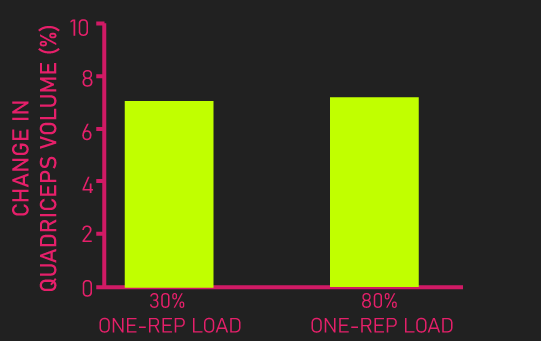
Why Light Loads Can Maximize Hypertrophy
One strong reason behind why loads as light as this can produce similar growth to heavier loads relates to mechanical tension. This is probably the best-understood mechanism of muscle growth at this time.
A key component of mechanical tension is active tension. This is equal to the force produced by a muscle. High levels of muscle fiber recruitment and high levels of force generated by the recruited muscle fibers means high levels of active tension and by extension, mechanical tension.
Heavier loads readily demand high levels of muscle fiber recruitment and high levels of force produced by the individual muscle fibers. As you near failure, these things would likely increase further to a degree.
However, evidence indicates light loads can achieve these conditions too. Taking a light load to or very close to failure will require increased muscle fiber recruitment and force produced by the individual muscle fibers. Ultimately resulting in a similar stimulus to heavier loads.
If we were to take these ideas alone, an interesting question arises. Why would a load be too light for muscle growth? So long as we take any load to or very close to failure, surely high levels of muscle fiber recruitment, and high levels of force produced by those fibers, are present.
Why a Load May Be Too Light for Maximizing Hypertrophy
1000 reps, so long as the last rep was a failure, should be as good as 10 reps to failure. However, instinctively this does not sound right.
One potential hypothesis that can help us here relates to central fatigue.
Remember, the reason muscles produce force is because they receive electrical signals originating from the central nervous system (so, the brain and spinal cord). Simply, the more electrical signals a muscle receives, the more muscle fibers are recruited and the more force produced by the recruited muscle fibers.
Central fatigue refers to a decrease in the electrical signals sent down to the muscle by the nervous system. This results in a reduction in muscle fiber recruitment and less force produced by some recruited muscle fibers.
Opposite to what seems to be popular belief, low load longer duration sets appear to produce more central fatigue than higher load shorter duration sets.
For instance, Yoon et al. had 9 men and 9 women, on separate days, perform a contraction of their biceps at either 20% of their maximum voluntary contraction force or 80% of their maximum voluntary contraction force. They held each contraction until force declined by 10% of the target force.
On average, subjects held the 20% contraction for around 14 minutes before they could no longer produce the required force, whereas the 80% contraction was only held for around 25 seconds.
But, the 20% contraction produced greater central fatigue than the 80% contraction.

Other studies also support these findings. (one, two, three)
During sets on typical exercises, some degree of central fatigue will probably be present. As just established, lighter loads, when taken to or close to failure, would produce more central fatigue than heavier loads.
Given evidence indicates loads as light as 30% one-rep max can produce similar hypertrophy to heavier loads, we can safely say any central fatigue produced with this load is probably not an issue.
But it possible that some load below 30% of your one-rep max, whereby if taken to failure, may fail to achieve sufficiently high levels of muscle fiber recruitment and force produced by recruited muscles, due to the interference of central fatigue.
Before moving on, if you’re curious about creating an effective training program for muscle hypertrophy, our high quality partner Alpha Progression can help. It can generate a highly effective program for you, track your workouts live with in-built progression recommendations, provide graphs displaying your long term progress, and it has a massive exercise database with more than 550 exercises.
Click HERE (the link opens in a new tab) to get a free 2 week trial of the apps features. If you like it and go beyond, the link also gives you 20% off a subscription!
We never promote trash at the House of Hypertrophy, so rest assured the app is high quality. The reviews speak to this, 4.8 starts (based on more than 7,000 reviews) on Google play, and 4.9 stars in Apple’s store (based on nearly 400 ratings).
How Light Is Too Light: The Research
Let us now move away from the theory and look at the actual research.
There have been a few papers assessing the impact of using loads below 30% one-rep max for hypertrophy.
Some of these failed to have subjects train to failure, which isn’t really helpful, so we won’t bother evaluating them (Holm et al., Jackson et al., & Barcelos et al.).
Jessee et al. had untrained men and women perform 4 sets on the knee extension to volitional failure either with a 15% one-rep max load or 70% one-rep max load. Subjects trained twice per week for 8 weeks.
I should note that with the 15% one-rep max condition, if any subject got up to 90 reps, the set was stopped even if they did not reach volitional failure. Ultimately, only 2 subjects out of 40 achieved this for all 4 sets, so it’s probably not an issue.
Increases in lateral and anterior thigh thickness were similar between the 15% and 70% one-rep max conditions. Indicating a 15% one-rep max load may still be able to maximize hypertrophy.
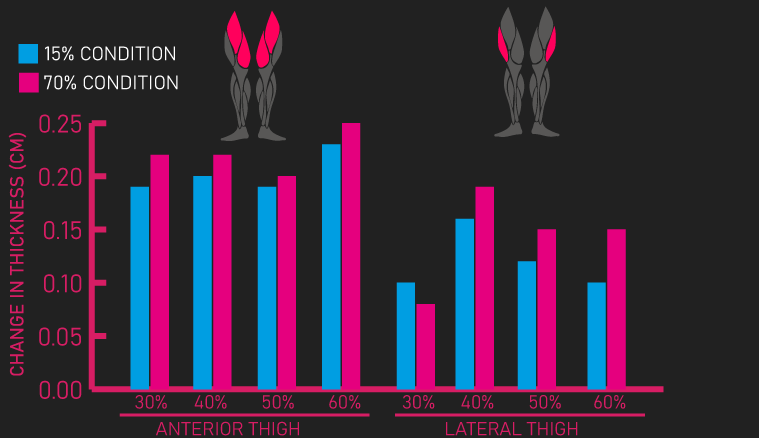
An interesting thing about this study was the 15% one-rep max condition had subjects use only a 30-second rest interval between sets, while the 70% one-rep max condition had subjects use a 90-second rest interval. This did not seem to impact the results.
However, there is research that conflicts with this study.
Buckner et al. had untrained men and women perform 4 sets to volitional failure on the dumbbell biceps curl with either a 15% one-rep max load or 70% one-rep max load. Subjects trained twice per week for 8 weeks.
Like the last study, if subjects were able to get up to 90 reps with the 15% one-rep max condition, the set was stopped even if they had not reached volitional failure. Based on the data provided, subjects in the 15% one-rep max condition, on average, reached 90 reps on the first set, but from sets 2 to 4, their sets were terminated before 90 reps, indicating they achieved volitional failure.
Increases in elbow flexor thickness at 50% and 60% of the upper arm length were greater for the 70% one-rep max condition. Suggesting a 15% one-rep max load may be too light to maximize muscle growth.
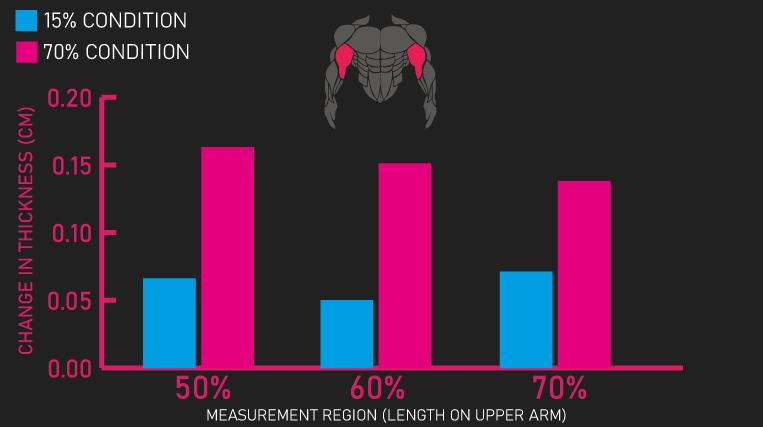
This study was pretty much identical in design to the previous study. They also had the 15% one-rep max condition use 30-second rest intervals between sets, while the 70% one-rep max condition used 90-second rest intervals. This could have impacted the results, but given it did not impact the Jesse et al. results, it’s difficult to say.
Interestingly, the only difference between these two studies was the Jessee et al. study used leg extensions, while the Buckner et al. study used the dumbbell biceps curl. Maybe a 15% one-rep max load can maximize muscle growth with the lower body, but not with the muscles of the upper body.
However, a study by Lasevicius et al. would question this. They had untrained men train the dumbbell biceps curl and leg press for an average of 3 to 5 sets to failure, twice per week for 12 weeks. Subjects either used a 20%, 40%, 60%, or 80% one-rep max load with each exercise. All conditions involved 120 seconds of rest between sets.
Increases in cross-sectional area of the elbow flexors and vastus lateralis were similar between the 40%, 60%, and 80% one-rep max conditions, and all greater than the 20% one-rep max condition. Indicating a 20% one-rep max load is not able to maximize muscle growth.
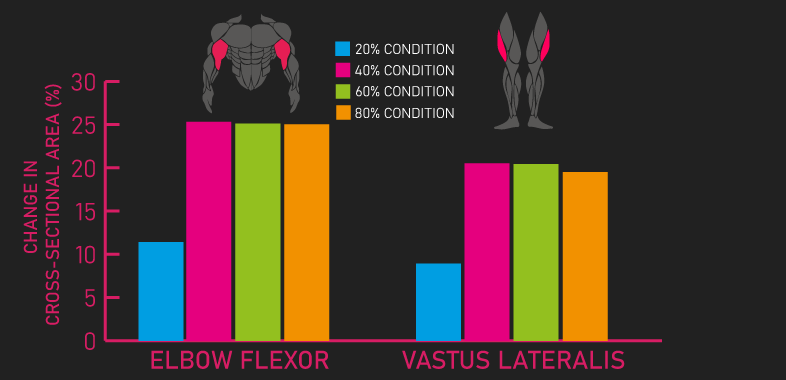
A study by Roie et al. further confuses things. They had older untrained men and women train the leg press and leg extension twice per week for 12 weeks. Subjects either trained each exercise with 1 set to failure with a 20% one-rep max load or they trained each exercise with 2 sets to failure with an 80% one-rep max load. All subjects used 2 minutes of rest between sets.
Increases in upper leg volume were similar between both groups, suggesting a 20% one-rep max load can maximize muscle growth.
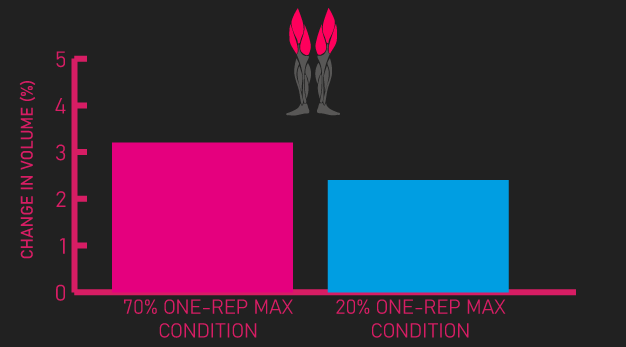
Interestingly, the 20% one-rep max condition involved only 1 set, while the 80% one-rep max condition involved 2 sets. The extra set did not seem to help the 80% one-rep max condition.
Now, the subjects were older men and women, so it’s not clear how this study design would impact young men and women.
Conclusion
To sum up, the current evidence, unfortunately, does not give us a straight answer.
Two studies indicate loads between 15% and 20% one-rep max can maximize hypertrophy, albeit one study was done on older subjects, while two other studies suggest loads between 15% and 20% one-rep max do not maximize hypertrophy.
Because of the conflicting evidence, it’s probably sensible to ensure that if your goal is hypertrophy, most of your training should be done within the 30% to 85% one-rep max zone. Generally speaking though, although loads as low as 30% one-rep max appear to be able to maximize growth, I don’t think many regularly train with this type of loading. Most people tend to find light-load training much more miserable and painful than heavier-load training.
That said, an interesting question is whether alternating rep ranges (mixing the loads you use) in your training program could improve muscle growth. We’ve covered all the research relating to this in another article.
Although this article may not have much practical takeaway, hopefully it was helpful in some form.
Remember to feel free to check out the Alpha Progression App if you’re interested. Also feel free to check out our free bench press e-book below.

